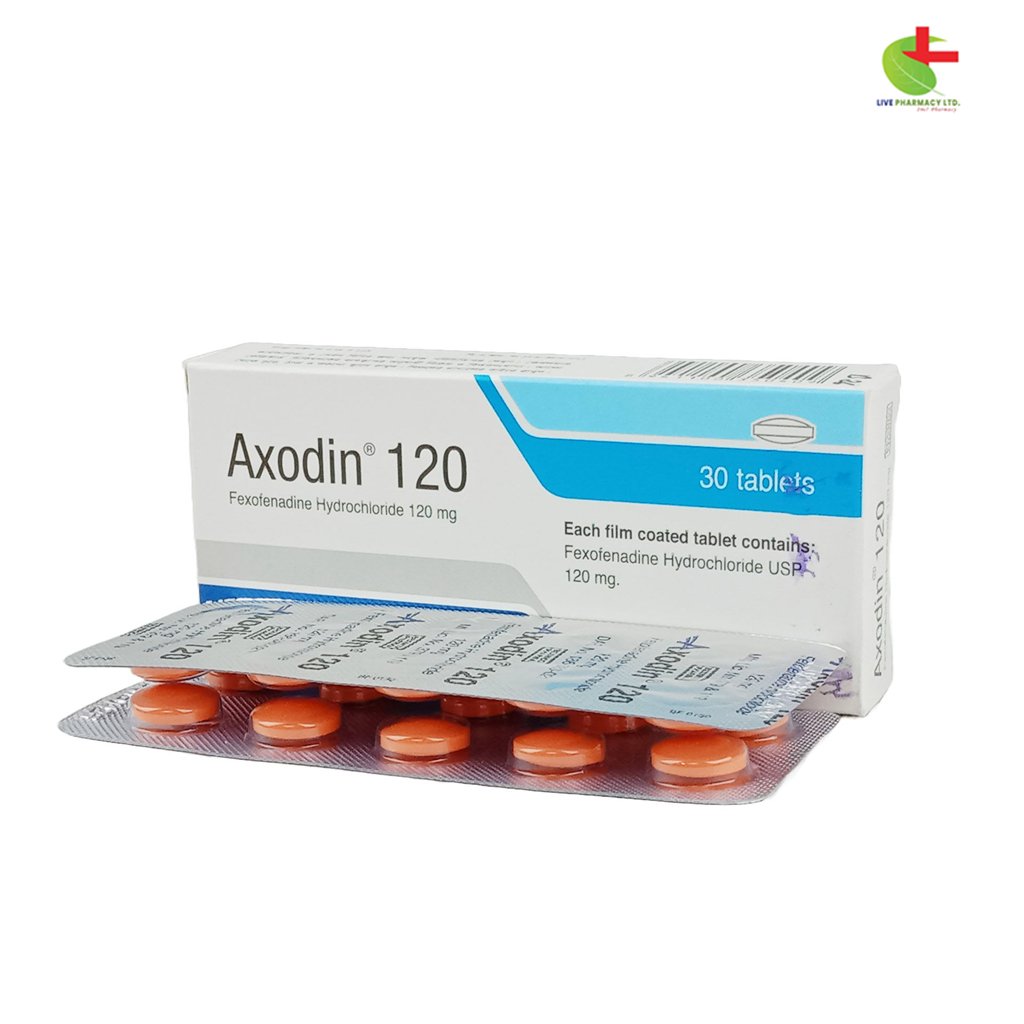Axodin 120
70.00৳ Strip
- Axodin is a non-sedating antihistamine containing Fexofenadine, used to alleviate symptoms of allergic rhinitis and chronic idiopathic urticaria in adults and children over 12.
- It effectively reduces sneezing, runny nose, itchy eyes, and hives by blocking H1 receptors without crossing the blood-brain barrier.
- Axodin enhances quality of life and productivity while minimizing central nervous system effects.
 Brand
Brand
|
Beximco Pharmaceuticals Ltd |
|---|---|
 Generics
Generics
|
Fexofenadine Hydrochloride |
 Type
Type
|
Tablet |
0
People watching this product now!
Description
Indications
- Allergic Rhinitis: Axodin is used to relieve symptoms of seasonal and perennial allergic rhinitis in adults and children aged 12 and older. It effectively addresses sneezing, runny nose, itchy or watery eyes, and itching of the nose, palate, or throat, improving overall quality of life and productivity.
- Chronic Idiopathic Urticaria: Axodin is indicated for alleviating symptoms of chronic idiopathic urticaria in adults and children aged 12 and older. It reduces wheals, itching, and improves quality of life and productivity.
Pharmacology
Axodin contains Fexofenadine, a selective H1 receptor antagonist. It works by inhibiting the activation of H1 receptors, preventing the release of histamine and other inflammatory mediators that cause allergic symptoms like itching, runny nose, and watery eyes. Unlike other antihistamines, Fexofenadine does not cross the blood-brain barrier, minimizing central nervous system effects.
Dosage & Administration
- Allergic Rhinitis:
- Adults and children 12 years and older: 60 mg twice daily or 120 mg/180 mg once daily. For those with impaired renal function: 60 mg once daily.
- Children 6 to 11 years: 30 mg twice daily or 60 mg once daily. For impaired renal function: 30 mg once daily.
- Children 2 to 11 years: 30 mg (5 ml) twice daily. For impaired renal function: 30 mg (5 ml) once daily.
- Chronic Idiopathic Urticaria:
- Adults and children 12 years and older: 60 mg twice daily or 120 mg/180 mg once daily. For impaired renal function: 60 mg once daily.
- Children 6 to 11 years: 30 mg twice daily or 60 mg once daily. For impaired renal function: 30 mg once daily.
- Children 6 months to under 2 years: 15 mg (2.5 ml) twice daily. For impaired renal function: 15 mg (2.5 ml) once daily.
- Children 2 to 11 years: 30 mg (5 ml) twice daily. For impaired renal function: 30 mg (5 ml) once daily.
Interactions
- Antacids: Reduce bioavailability if taken within 2 hours before Axodin.
- Erythromycin & Ketoconazole: Can increase Fexofenadine levels but no significant QT interval effects or increased adverse reactions observed.
Contraindications
- Hypersensitivity: Do not use in individuals allergic to Fexofenadine or any of its components.
- Liver Disease: Avoid in combination with HMG-CoA reductase inhibitors in patients with active liver disease or unexplained persistent transaminase elevations.
Side Effects
- Common: Headache, drowsiness, dizziness, nausea.
- Rare: Hypersensitivity reactions, insomnia, tachycardia, rash.
Pregnancy & Lactation
- Pregnancy: Use only if the benefits outweigh the risks to the fetus.
- Lactation: Not recommended as Fexofenadine can be present in breast milk.
Precautions & Warnings
- Renal & Hepatic Impairment: Adjust dosage accordingly.
- Elderly: Monitor for increased bioavailability and potential effects.
Use in Special Populations
- Children: Not recommended under 2 years. For those aged 2-11 years, use with caution and adjust dosage for impaired renal function.
- Overdose: Dizziness, drowsiness, and dry mouth may occur. Symptomatic treatment is recommended; haemodialysis is ineffective.
Therapeutic Class
Non-sedating antihistamines
Storage Conditions
Store in a cool, dry place away from light and heat. Keep out of reach of children.
Reviews (0)
Be the first to review “Axodin 120” Cancel reply
About brand
Shipping & Delivery













Reviews
There are no reviews yet.